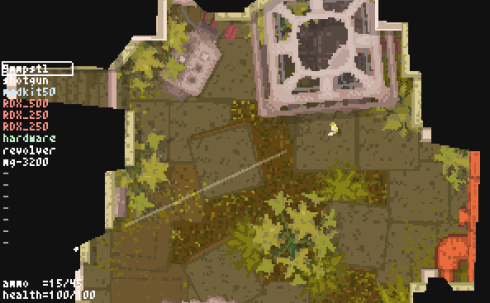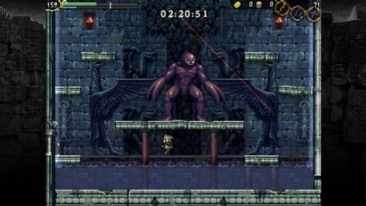Developer Summary:
Teleglitch is a roguelike top-down shooter with pixel graphics. The game takes place in a procedurally generated military research & training complex that has a different map every time you play. Our mission is to give players like you a chance to walk in the dark corridors, gripping their gun and few last rounds of ammunition. To play with finger on the trigger, high on adrenaline. We want to give you the paranoid, sweaty, and bloody hard kind of fun.
What We Think:
Sometimes roguelikes are not always turn-based. Sometimes shooters are not always First Person. Three years in the making, Teleglitch is both and neither. It is at once a fast-paced arcade-style action game inspired by DOOM, and a randomly generated, single-life, intense roguelike.

Teleglitch uses stylized, pixelated graphics we’ve grown accustomed to seeing these days. In this case, it adds to the experience, as a lot of the horrors within the abandoned space complex get more freakish with the aid of your imagination filling in the gaps: I wish I could draw a picture of my last seconds alive from just my last run, before I opened a door leading right into the ‘face’ of a mechanical Beholder before I was disintegrated by its eyeball laser blast death-ray. That’s what makes permadeath in roguelikes so appealing; every life, every death is memorable. And by all means, it’s definitely the case here.
A Fast-Paced Rogue-Like?!?
In Teleglitch, the levels are randomly generated, and this is used as part of the plot wherein something has gone awry with experiments being conducted in teleportation and genetics, causing the world to reconfigure itself. In literal terms, though they maintain a theme between each playthrough, the layout of the maps are different every time. Also, objects in room can be pushed around, a nice effect, giving the environment a more lively dynamic than just static set-dressing. Some walls are destructible as well and reveal hidden rooms that may store precious new objects, be it an empty can or stack of nails that can be later fashioned into makeshift weapons.
You begin armed with just a pistol and a knife, and unless you are a really good shot, you will need to learn to use that knife before you run out of bullets. Using the right mouse button, you draw and aim your weapon by way of a reticle and aiming line that is drawn from your character to the target. The game then progresses at such a great pace that you never truly feel safe or in control of the situation. There may be a moment where you think you can take out anything you come across, with a newly discovered weapon say, but the next new enemy that catches you off-guard will smack you right back to being a sniveling baby-steps-coward.

The enemies are individually dangerous in their own ways, with enough variety to keep you guessing what may show its ugly mug from around the next corner. Each new enemy you encounter is filed in the Monster Database that offers some helpful insights into their respective defenses and powers.
Early on in any given game, you will encounter easily disposed mutants and zombies. But your first encounter with enemies that shoot back will make you jump out of your seat. Soon, it’ll feel like every encounter in the later game is nothing but bosses, leaving you panting and sweaty-palmed. Maybe it’s just because it’s a roguelike, but very few games I played this year elicited such a strong visceral reaction from me. I think this was what the developers hoped to induce.

While you may be fragile, you’re not helpless; from mere strokes-of-luck finding weapons on the floor or in chests, to using a rather well-done crafting system to combine items into better, more useful, or entirely new items, there are ways in which you can be made to feel like you are getting a leg up on your foes. In some cases there are more than one recipe for the same item, and sometimes simply finding out that you can strap two shotguns together is enough to encourage you to press onward. Hitting the ‘C’ key shows you what items can be combined in various configurations to produce new items.
Staying healthy will also be a balancing act: Do you want to use a medpack to recover lost health? Or would you rather use it to create an item that would give you an extra life should you be caught so offguard that you would have otherwise been blasted to bits. Would you prefer to eat this ration now, or use it as a lure for a trap? By virtue of its Rogue genetics, Teleglitch makes every decision feel like one of life or death.
Teaching Old Dogs New Tricks
There is more to know about the visuals too than simply that they are of a pixelated style. Firing weapons causes a very cool RGB displacement effect. The screen lurches as bullets impact or bombs explode, and then there is the amazing implementation of line of sight techniques…
The most interesting feature in the game is the use of line-of-sight. From a technical standpoint, it’s implemented in a simple, but clever way; the camera for the game is looking down onto the field of play, and tall, black walls hover over all solid wall objects in the game. It’s similar but not identical to Andy Schatz’ Monaco. Herein, the crawling blackness takes on a sort of life of its own. Anything that would obscure visibility, even a simple column in a room, or an overturned table, results in a black void that moves in tandem with the direction your avatar is facing. It completes and bolsters the experience – not knowing what is behind a corner because of a near-accurate representation of a player-character’s sightlines.
The sound design is terrific, especially when wearing headphones – the explosions and gunshots have substantial heft on the low end of the spectrum, but sound like a collection of cinematic sounds shoved through an 8-bit audio chip, which is a good analog to the visuals onscreen. There is no music per se, but the subtle ambient drone of machines humming, vapor spewing or cold winds blowing serve as an eerie bed that sustains tension, like the score for the original Texas Chainsaw Massacre, particularly when coupled with the rapid heartbeats that play whenever monsters launch themselves at you from across a room, accelerating as they get closer.

The story, while basically DOOM without the Hell part, is told through computer terminals scattered throughout the game. It is actually quite an engaging tale of which you can view a running log as it unfolds, and I found myself reading along with great interest. While I’d rather you discover the story on your own, it is entirely where the game gets its name as progress between levels is done by warping between Teleporters, some that refuse to play nice.
So far, I’ve found absolutely nothing to dislike about the game. It’s paced well. It’s fun. It’s intense. It stirs up real dread and excitement. I can’t feel but be forced to give it a perfect grade. It would be very nice to have even partial support for an XBOX gamepad controller, but the many action variables may make this a challenging implementation without any keyboard input whatsoever. So while it may not look like DOOM 3 or any modern game, Teleglitch is a brillianty-assembled bundle of survival/horror entertainment unto itself and one of the most interesting new entries in 2012.
Download the demo for Teleglitch or purchase the full game via the official site
Get Teleglitch on Desura
Get Teleglitch on Steam
(Die More Edition released July 24th, 2013)
[xrr rating=”5/5″]





Is it review or love letter to the game.
It is 10 € game, and should be jugged like one.
There is constructive criticism?
Teleglitch is not a Roguelike, and it’s very barely a Roguelikelike.
Thanks for your comment. It is interesting to note that the developers themselves call it a roguelike, which may have something to do with the way they programmed it, so you may want to take it up with them as well. It would be interesting to learn their own reasoning.
Nonetheless, I will allow the original reviewer to reply as well.